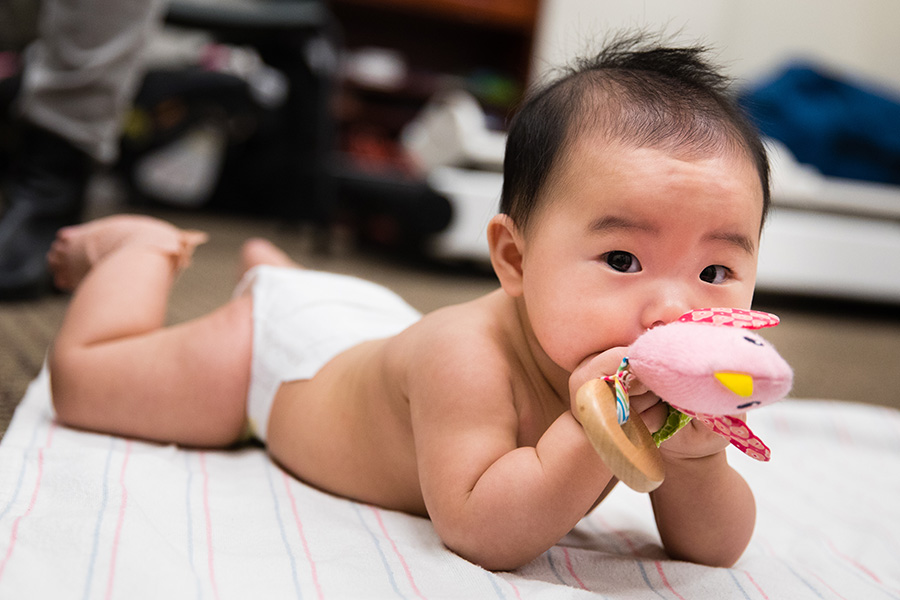Children who have an obese mother are 2-to-3 times more likely to be obese as well. Ellen Demerath wants to understand why this happens.
“We need to further explore the link between a mother’s weight, her nutrition, and her baby’s weight. We’re trying to cut off childhood obesity very early in the process,” she says.

The School of Public Health professor has worked throughout her career to understand how a mother’s nutrition may have an impact on a child’s weight. But, in 2012, she noticed a gap in the research — there hadn’t been a large, standardized study to investigate the role of hormones in breast milk on infant weight gain.
But she needed partners and found her match when she met David Fields at a conference. Fields, an associate professor at the University of Oklahoma College of Medicine, was already gathering samples of breast milk to study the link between the milk and body composition.
The two began working together to develop the MILK (Mothers and Infants LinKed for Healthy Growth) Study, which seeks to understand how breast milk is related to mother and infant weight gain and body composition.
In 2014, Fields and Demerath received $3.6 million from the National Institutes of Health’s National Institute for Child Health and Development for a five-year study and began recruiting their first cohort — 350 moms, who were recruited in pregnancy, and their newborn babies.
“We don’t know enough about what’s actually in breast milk. We know a lot about the benefits of breast milk and breastfeeding, but we don’t really know why these benefits exist,” says Demerath.
Moms and Babies in Science
While Fields created a cohort in Oklahoma, Demerath recruited moms across the Minneapolis/St. Paul area who were patients at HealthPartners clinics. They ranged across body mass indexes (BMI) — normal weight, overweight, and obese.
The mother and baby come to the University of Minnesota’s Center for Neurobehavioral Development (CNBD) at 1 month, 3 months, and 6 months. During the visit, researchers collect the mother’s milk and measure the baby’s muscle and fat amounts using a “pea pod.”

Facilitating the entire process is study coordinator Laurie Foster, who works with every mother and baby who are part of the study. “Meeting a mom with a newborn is a privilege. I’m part of their life at a very unique and special point in time when a lot is changing for the mom,” says Foster, who has a background in child development, parent education, and family social science. “I’m here to answer the mom’s questions and we talk a lot about what they’re experiencing during the three-hour initial visit while their baby is being measured and data is collected.”
“I’m curious to see how breast milk overall has an impact on their long-term health and their risks for obesity,” says Adrienne Kinde of Roseville, Minn., a mother of two daughters who have participated in the study.
All participants are exclusively breastfeeding at one month, so the results can be easily interpreted. By the three-month visit, some have quit breastfeeding and Demerath and her colleagues can see if a baby’s vitals change as the baby transitions to formula.
The study has also provided further insight into why moms with a higher BMI have more difficulty starting and continuing to breastfeed. The researchers found that women with a higher weight status produced less breast milk and a high blood sugar level in women was a predictor for how much milk would be produced.
What’s in the Milk?
Previous studies have shown that the breast milk of heavier mothers has higher levels of leptin, which is an appetite-suppressing hormone. This causes these women to have lower weight babies. “It’s counterintuitive because these women are more likely to have children who become proportionally heavier as they grow,” says Demerath.

So the MILK Study is investigating the role of hormones in infant appetites and satiation. “Leptin might be related to lower relative growth while a child is breastfeeding, but we’re working to discover how children’s bodies react once they’re off milk. We’re starting to wonder if these kids shoot up in weight once they’re done breastfeeding.”
While the current MILK study runs until 2019 and Demerath will publish further findings, Demerath is already applying for grants so she can continue to follow participants into their toddler years. “We’re thinking that the differences seen in breast milk don’t become evident until later in the child’s life when the child starts to be in control of what he or she is eating.”
The next phase would also explore the connection between a child’s growth and his or her microbiome, which refers to the combined genetic material of the bacteria found in a person’s digestive system. “In the womb, babies have no microbiome in their gut, but through the birthing process and through swallowing breast milk, the microbiome differentiates and grows. By the time infants are two years old, their microbiome looks the same as an adult’s.”
As Demerath aims to understand this, she’s already collecting samples from MILK participants to understand if the microbiome is influenced by the mother’s weight status.
Training Ground
The MILK study has provided an optimal opportunity for School of Public Health students interested in maternal and child health and nutrition to be part of a large-scale, epidemiological study.

Public Health Nutrition MPH student Regina Marino worked on the study through a research assistantship, which includes tuition benefits. “Being part of the MILK study has helped me narrow down my career interests and working with Ellen has shown me what it would be like to work in academia,” says Marino, whose main role in the study was managing the breast milk samples and conducting breast milk maconutrient composition analyses.
She’s also working with Demerath to publish research. “Before being part of the MILK Study, I had only done scientific writing in the classroom and Ellen taught me how to summarize findings in a succinct and concise way.”
Ghazaleh Sadr Dadres is a Maternal and Child Health MPH student who approached Demerath to work on the MILK study to fill a data analysis project requirement. “I learned analytical skills that broadened my knowledge on how to conduct and analyze a large-scale epidemiological study,” says Sadr Dadres, who is now working with Demerath to publish findings about prepregnancy and postpartum characteristics using MILK data. “I had a c-section and I was displeased with that. I want to improve the health of mothers and help them have better pregnancy outcomes.”
And the study’s home at CNBD allows for unique partnerships with researchers across the U of M. The center’s more than 40 members work throughout the health sciences and are looking at all angles of childhood development, from body composition and obesity to brain development and cardiovascular risk.
“As scientists, we have to cross silos to teach each other our languages,” says CNBD Director Dr. Michael Georgieff, who researches the relationship between body composition and brain development.
“Through working with public health researchers, I’ve learned how to link health outcomes to policy. In clinical research, we often have our finding and talk only about that, but working with public health researchers has really forced me to ask, ‘So what are we going to do about this? How can we translate and educate our finding?’ I wouldn’t have a clue how to talk about this if I didn’t have a collaborator like Ellen.”
Collaborations like these allow public health to enter the child development research sphere in new ways. “Many researchers focus solely on the child or the family,” says Demerath. “But public health looks at other factors, such as the social determinants of health, and uses epidemiological study design and methods to understand the full picture.”

